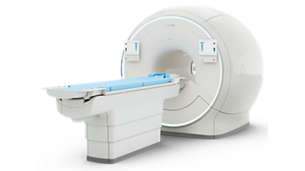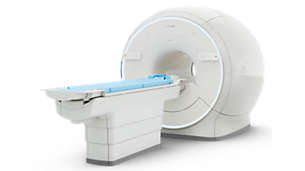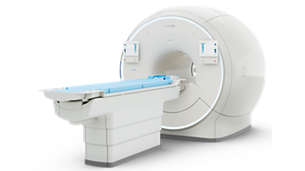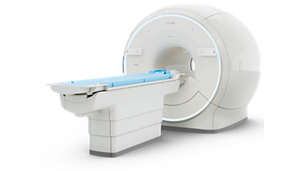MR ScanWise Implant (MROC)
Confidently scan patients with MR Conditional implants
Demonstrated results for ScanWise Implant
100%
of technologists feel more confident to examine and manage patients with MR Conditional implants.1
3 minutes
or less to enter implant conditions.
1 time
setting the parameters for the complete set of protocols.
Features

Easy set-up of scanning parameters
MR ScanWise Implant helps to reduce guesswork and additional user calculations by guiding the user through simple steps to enter the MR Conditional parameters as specified by the implant manufacturer. You don’t need to do any calculations or repeatedly add or check information for every sequence of your exam.

Set parameters for all scans only once
With MR ScanWise Implant you enter the parameter values of the Conditional implant only once for the whole exam, rather than scan by scan. It automatically adjusts the scan parameters for all scans and pre-scans.

Enter limits in three minutes or less
MR ScanWise Implant promotes efficiency. With the help of the guided user interface the implant conditions can be entered in three minutes or less.

Improve visualization around orthopedic implants
When imaging near an MR Conditional orthopedic implant, Orthopedic Metal Artifact Reduction O-MAR2 and O-MAR XD2 complement ScanWise Implant by reducing near metal susceptibility artifacts. This improves the visualization of more soft tissue and bone in the vicinity of the implant.

SmartSpeed Implant
Performing musculoskeletal (MSK) imaging in patients with implants is challenging. With the introduction of technologies such as Orthopedic Metal Artifact Reduction (O-MAR XD), image quality has substantially improved. However, scan times are longer. With Philips SmartSpeed Implant, the technology of O-MAR XD is integrated in the Philips SmartSpeed Engine to reduce the scan time of the non-Cartesian sequences significantly.3

MR Workspace
MR Workspace is the MR console designed to support efficiency and staff satisfaction in the control room through integrated AI assistance, task guidance and automation. It helps technologists to manage their workload and keep the daily schedule under control while maintaining focus on the patient. It provides guided and automated workflow and includes step-by-step coaching towards AV analysis. 80% of examination planning is fully automated and results are sent to PACS in 30% less time16.
MR ScanWise Implant technology is available on
-
MR 7700
Experience breakthrough innovation in 3.0T imaging with the unique design of the Philips MR 7700 imaging system, enhanced with XP gradients and artificial intelligence (AI). The system is built to address a pressing need to deliver on the clinical expectations of today, and to facilitate the most demanding research programs. The MR 7700 provides high accuracy, power, and endurance to support confident diagnosis for every patient. It is the system of choice for highest quality diffusion imaging and advanced neuroscience. Extend your scanning capabilities with a fully integrated multi-nuclei imaging and spectroscopy solution to explore new clinical pathways without sacrificing clinical imaging workflow or wide-bore patient comfort. What’s more? The MR 7700 promises a great experience for both users and patients through the ease-of-use features of a well-designed clinical 3.0T scanner together with a no compromise workflow. Now scientists and clinicians alike can schedule without conflict.
NMRF429 -
Ingenia Elition 3.0T X
The Philips Ingenia Elition solution offers cutting-edge MR imaging techniques, while setting new standards for clinical research in 3.0T imaging based on gradient- and RF designs. The Ingenia Elition delivers on superb image quality, and performs MRI exams up to 50% faster¹. Fast overall exam-time is achieved by improving patient handling setup time at the bore with the touchless guided patient setup, combined with accelerations in both 2D- and 3D scanning. Furthermore, the Ingenia Elition offers an immersive audio-visual experience to calm patients and guide them through MR exams.
781358 -
Ingenia Elition 3.0T S
The Ingenia Elition S delivers superb image quality and performs MRI exams up to 50% faster¹. Compressed SENSE accelerates in both 2D- and 3D scanning. High productivity is achieved with the help of imaging capabilities such as SmartExam⁷, 4D Multi-Transmit and ScanWise Implant⁹. These advances have been made possible by a combination of new gradient and RF designs, plus acceleration technologies like Compressed SENSE. Furthermore, the Ingenia Elition S offers an immersive audiovisual experience to help calm patients and guide them through exams, enhancing the MR experience.
781357 -
Ingenia Ambition 1.5T X
Based on its revolutionary fully sealed BlueSeal magnet, Ingenia Ambition X lets you experience more productive¹ helium-free MR operations. The Ingenia Ambition X delivers superb image quality, with up to 80% higher sharpness⁷, even for challenging patients, and performs MRI exams up to 3x faster² with SmartSpeed Precise accelerations for all anatomies. Fast overall exam-time is further achieved by simplifying patient handling at the bore with the guided patient setup. Furthermore, the Ingenia Ambition X offers an immersive audio-visual experience to help calm patients and guide them through MR exams.
781356 -
Ingenia Ambition 1.5T S
Based on its revolutionary fully sealed BlueSeal magnet, Ingenia Ambition S lets you experience more productive¹ helium-free MR operations. The Ingenia Ambition S delivers superb image quality, with up to 80% higher sharpness⁷, even for challenging patients, and performs MRI exams up to 3x faster² with SmartSpeed Precise accelerations for all anatomies. Fast overall exam-time is further achieved by simplifying patient handling at the bore with the guided patient setup. Furthermore, the Ingenia Ambition S offers an immersive audio-visual experience to help calm patients and guide them through MR exams.
781359 -
MR 5300
This innovative 1.5T MRI system is powered by Philips exclusive BlueSeal magnet for helium-free operations. And it incorporates a wealth of AI²-driven technologies to simplify and automate the most complex clinical and operational tasks. So you can focus on what matters the most: your patients. This breakthrough solution is designed to help boost MR productivity, speed up exams, empower clinicians to make informed clinical decisions, and control the costs of MR imaging.
782110
“The Philips ScanWise solution is a controlled and reassuring, step by step process, that based on the implant guidelines will set all of your parameters needs in one simple process, not only sequence by sequence but for all sequences in your examination.”
Lawrence N. Tanenbaum, MD, FACR
VP and Chief Technology Officer
RadNet, Inc., Los Angeles, USA
“From a technologist’s perspective, we’re excited about the prospect of shortening exam times and broadening the diagnostic modalities available for those patients with MR Conditional implants. Philips understands the needs of radiologists and brings the expertise needed to create a smart solution to help guide operators to meet the specific criteria for each implant.”
Scott G. Hipko, BSRT(R)(MR)(CT) MRSO
Chief MRI Research Technologist
University of Vermont Medical Center, Burlington, Vermont, USA

Compliant with IEC guideline for scanning patients with MR Conditional implants
IEC 60601-2-33 (2022) requires MROC (Magnetic Resonance Output Conditioning) for 1.5T and 3.0T for scanning patients with MR Conditional implants. Philips ScanWise Implant complies with the IEC guideline and offers even more by implementing the mandatory and optional features to control any condition value.
Frequently asked questions
- Why is it important to give patients with implants access to MRI?
-
As we get older, many of us have an increased chance of experiencing musculoskeletal, cardiovascular and neurological diseases as well as diabetes. We also run a higher risk of developing more than one clinical condition, either chronic or acute. Access to diagnostic imaging will be required for many patients that already suffer from another disease. For example, studies of the prevalence of comorbidity show that at age 70, having three or four conditions is not uncommon4. While oncology was not included in this assessment, advances in treatment and medical care is expected to soon transform several cancers into chronic diseases.
Today, treatment of many chronic conditions involves the placement of implants or use of body-worn treatment-delivery devices. Millions of patients benefit from passive implants, like hip or knee replacements, spine stabilization devices, vascular stents, clips or coils. Many others depend on active implants or devices, requiring electrical power and logic components to operate, like pacemakers, neuro stimulators, insulin pumps, spine pain-relief stimulators and cochlear implants.
For numerous medical conditions, MRI is the modality of choice5-9 recommended by consensus guidelines for diagnosis and treatment monitoring. Current medical practice, however, excludes patients with an implant from access to MRI, based on serious and valid safety concerns. This “clash of technologies”10 results in unnecessary health inequalities for a rapidly growing group of patients.
- Why are conditions applied for implants in the MRI?
-
Implants must be strong for musculoskeletal applications or flexible, for instance when used as stents, and biocompatible. Active implants must sense or stimulate electrophysiological signals from the heart or the central nervous system.11 Their microcontrollers and electronics must be protected against electromagnetic interferences in everyday life. All these requirements suggest the use of metallic structures, which can be problematic when brought near or inside an MRI system. This is particularly true because the strong electromagnetic fields required for MRI far exceed the electromagnetic fields encountered in urban environments.
- How can you comply to requirements of MR Conditional implants?
-
Scanning patients with passive or active implants requires having significant additional organizational measures in place at the hospital. Retrieval and interpretation of MR Conditional implant labeling must be organized in a multidisciplinary team. Cross-industry harmonization and standardization efforts by IEC and ISO14 and FDA guidance12 have improved the availability of information to support the clinical decision to scan in compliance with MR Conditional labeling.
Users should understand the possible interactions between implants and the MRI system, and should be able to identify related safety concerns. The required precautions related to implants can be divided into two categories:13,14
- The always-present static magnetic field B0 can cause attraction and device malfunction. Pacemakers may reset to programming mode, and become nonfunctional, when the magnetic field exceeds the very small value of 0.5 mT (5 Gauss). While current standards15 specify a safe limit of 1 mT (10 Gauss), older implanted devices may still be affected at 0.5 mT (5 Gauss), the value specified for delimiting the Controlled Access Area in IEC60601-2-33.
- RF pulses and switching gradients must be emitted to acquire the MR image. These outputs can be reduced by implementing and applying appropriate controls in the MRI sequences.
It is of paramount importance to perform all safety checks related to the static magnetic field before admitting a patient into the MRI suite. These checks should be done independently, and at every decision point in the workflow, by the referring physician, the radiologist and the operator.
This leads to the following typical workflow steps:14
- Check for the presence of an active implant. Ensure that the implant will not become dysfunctional when critical for life support. Keep the patient out of the 0.5 mT (5 Gauss) line.
- Check for the Static Field Gradient condition and verify the related exclusion zones around the magnet. Make sure that the implant does not enter these areas.
- Check RF output (SAR or B1+rms) and gradient (slew rate or dB/dt) limitations. When defining the examination protocol, make sure that each and every sequence complies with these restrictions.
Documentation
- Brochure
-
- Whitepaper
-
Footnotes
[1] Results based on survey from 9 technologists in SCM IRM Belledone. Results from case studies are not predictive of results in other cases. Results in other cases may vary. [2] Only for use with MR Safe or MR Conditional Implants by strictly following the Instructions For Use. [3] Compared to Philips O-MAR XD. [4] Barnett K et al. Epidemiology of multimorbidity and implications for healthcare, research, and medical education: a cross-sectional study. Lancet. 2012;380:37–43. [5] Tatlisumak T, Is CT or MRI the Method of Choice for Imaging Patients With Acute Stroke? Why Should Men Divide if Fate Has United? Stroke. 2002;33:2144 –2145. [6] Kayhan A et al. Dynamic contrast-enhanced magnetic resonance imaging in prostate cancer. Magn Reson Imaging. 2009 Apr;20(2):105-12. [7] Demehri S et al. Conventional and novel imaging modalities in osteoarthritis: current state of the evidence. Curr Opin Rheumatol. 2015 May;27(3):295-303. [8] Parizel PM et al. “Magnetic resonance imaging of the brain”, in Reimer P et al. (eds.) Clinical MR Imaging (2010) 107-195, Springer- Verlag Berlin Heidelberg. [9] Filippi M et al. “EFNS task force: the use of neuroimaging in the diagnosis of dementia” Eur J Neurol (2012) 19: 1487–1511. [10] Ferreira AM et al. MRI-conditional pacemakers: current perspectives. Medical Devices: Evidence and Research. 2014;7:115–124. [11] Beinart R and Nazarian S. Effects of External Electrical and Magnetic Fields on Pacemakers and Defibrillators. From Engineering Principles to Clinical Practice. Circulation. 2013;128:2799-2809. [12] Guidance for Industry and Food and Drug Administration Staff. Establishing Safety and Compatibility of Passive Implants in the Magnetic Resonance (MR) Environment. 2014;1685. [13] IEC 60601-2-33. Edition 3.2 2015-06. Medical electrical equipment –Part 2-33: Particular requirements for the basic safety and essential performance of magnetic resonance equipment for medical diagnosis. [14] Emanuel Kanal et al. ACR Guidance Document on MR Safe Practices: 2013. Journal Of Magnetic Resonance Imaging 37:501–530 (2013) [15] EN 50527-2-1:2011. Procedure for the assessment of the exposure to electromagnetic fields of workers bearing active implantable medical devices. Part 2-1: Specific assessment for workers with cardiac pacemakers. [16] Compared to a workstation.








